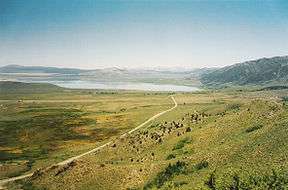Mono Basin
| Mono Basin | |
|---|---|
|
Mono Basin from near Conway Summit. | |
| Location | Mono County, California, United States |
| Floor elevation | 6,380 feet (1,940 m) |
| Area | 631 to 801 square miles (1,630 to 2,070 km2) |
| Depth | 6,680 feet (2,040 m) |
| Geography | |
| Coordinates | 37°57′N 118°57′W / 37.950°N 118.950°WCoordinates: 37°57′N 118°57′W / 37.950°N 118.950°W[1] |
The Mono Basin is an endorheic drainage basin located east of Yosemite National Park in California and Nevada.[2][3] It is bordered to the west by the Sierra Nevada, to the east by the Cowtrack Mountains, to the north by the Bodie Hills, and to the south by the north ridge of the Long Valley Caldera.[4]
Estimates of the size of the basin range from 634 to 801 square miles, and the basin's elevation ranges from around 6,380 feet (level of Mono Lake as of 1986) to 13,061 feet atop Mount Dana near the Sierra Crest.[5][6][7]
Notable features in the basin include Mono Lake and the Mono-Inyo Craters, as well as the town of Lee Vining.
Geology
Geologically the basin is a structural basin that is bordered to the west by the frontal fault of the Sierra Nevada. The basin is part of the Walker Lane, an area where much of the deformation between the North American Plate and the Pacific Plate occurs.[8] The basin was created by geological forces over the last five million years by crustal stretching of the Basin and Range province and associated volcanism and faulting at the base of the Sierra Nevada.[9] Five million years ago, the Sierra Nevada was an eroded set of rolling hills and Mono Basin and Owens Valley did not yet exist.
From 4.5 to 2.6 million years ago, large volumes of basalt were erupted around what is now Cowtrack Mountain (east and south of Mono Basin); eventually covering 300 square miles (780 km2) and reaching a maximum thickness of 600 feet (180 m).[9] Later volcanism in the area occurred 3.8 million to 250,000 years ago.[10] This activity was northwest of Mono Basin and included the formation of Aurora Crater, Beauty Peak, Cedar Hill (later an island in the highest stands of Mono Lake), and Mount Hicks. The area remains volcanically active today, with Paoha Island forming from volcanic activity 350 years ago.[11]
See also
Footnotes
- ↑ "Mono Basin". Geographic Names Information System. United States Geological Survey.
- ↑ Mono Basin Ecosystem Study Committee, National Research Council (1987). The Mono Basin ecosystem : effects of changing lake level. Washington, D.C.: National Academy Press. p. 1. ISBN 978-0-309-03777-8. Retrieved 28 January 2011.
- ↑ Schweich, Tom. "Overview Map of Mono Basin". Eastern Mojave Vegetation. Retrieved 28 January 2011.
- ↑ Mono Basin, Mono County, California
- ↑ Mono Basin Ecosystem Study Committee, National Research Council (1987). The Mono Basin ecosystem : effects of changing lake level. Washington, D.C.: National Academy Press. p. 13. ISBN 978-0-309-03777-8. Retrieved 28 January 2011.
- ↑ "Mono Basin EIR" (PDF). May 1993. p. 3A–6. Retrieved 28 January 2011.
- ↑ "Mount Dana". NGS data sheet. U.S. National Geodetic Survey.
- ↑ Jayko, Angela. "Geology of Federal Lands in the Eastern Sierra Region, southwestern Great Basin". Geology of Parks and Federal Lands of the Southwest. USGS. Retrieved 2013-02-14.
- 1 2 Tierney 2000, p. 45.
- ↑ Tierney 2000, p. 46.
- ↑ Hill 2006, p. 237.
References
- Hill, Mary (2006). Geology of the Sierra Nevada. California Natural History Guides. 80 (2nd ed.). University of California Press.
- Tierney, Timothy (2000). Geology of the Mono Basin (revised ed.). Lee Vining, California: Kutsavi Press, Mono Lake Committee. ISBN 0-939716-08-9.
